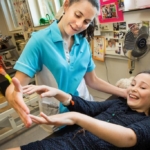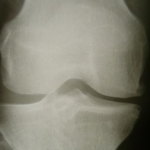Optimize bracing for knee OA
Significant improvements in pain, function and loading, and propulsive forces were seen with the valgus brace.

Evoke™ knee brace highlights. OssKin
By Larry Hand, Lower Extremity Review November 2013
Treatment with a simple brace showed only significant improvements in loading forces. Our findings suggest that although both braces improved confidence and function during gait, the valgus brace showed greater benefit. JD Richards, et al.[7]
Research continues to suggest that bracing has the ability to improve pain and function in patients with knee osteoarthritis in a controlled setting, but researchers are now working to identify factors that affect bracing outcomes in the real world. Patient expectations are at the top of that list.
Recent studies have reported a number of benefits associated with bracing for knee osteoarthritis (OA). The mechanisms underlying those benefits are still under investigation, but researchers are increasingly teasing out factors that are most likely to lead to positive outcomes.
| Expectations and communication |
One category of such influential factors involves patient expectations, as researchers from the Steadman Philippon Research Institute (SPRI) in Vail, CO, discovered in conjunction with their 2012 study of an off-the-shelf unloader brace.[1]
In the study 39 men and women (average age, 61 years) with unicompartmental knee OA were braced for a minimum of six months and filled out questionnaires at enrollment, three weeks, six weeks, and six months. Thirty patients used medial unloader braces and nine used lateral unloader braces.
The researchers measured 20 patient-expectation domains before bracing began. Factors described as “very important” included having confidence in the knee (97% of patients), improving the ability to maintain general health (93%), avoiding future knee degeneration (90%), and returning to recreational sports (83%). Pain relief was very important to 69%, while 39% expected most pain to be relieved and 57% expected all pain to be relieved.
Overall, patients experienced significant improvement in pain, stiffness, and function components of the Western Ontario and McMaster University Osteoarthritis (WOMAC) index, with similar results for medial and lateral compartments. At the study’s end (six months after brace application) 25% of the patients reported taking fewer pain medicines overall, 31% reported taking fewer over-the-counter anti-inflammatory drugs, and 35% reported taking fewer prescription anti-inflammatories. The researchers are now investigating whether prebracing expectations are associated with postbracing outcomes.
“What the study shows is that people who have disabilities due to osteoarthritis can improve their quality of life with an unloader brace, whether they use it for sporting or daily activities,” first author Karen Briggs, MBA, MPH, director of SPRI’s Center for Outcomes-Based Orthopaedic Research, told LER.
In addition to key clinical outcomes, it’s all about expectations and communication, Briggs said.
“If a patient comes in expecting to be a professional ball player when they are done and they weren’t a professional ball player to begin with, we have a problem. Every treatment has to fit within a patient’s expectations, and we have to manage those expectations,” she said. “If doctors know what patients are expecting, treatments can be matched to these expectations, which will then lead to patients being satisfied with the treatment, which is really critical. It was critical that these people were very interested in improving their well-being and that’s what happened.”
Clinicians at SPRI use a validated expectation questionnaire for all patients, emailing it to them before their follow-up appointment. Doctors review patient outcome scores, using an internally developed “Patient Report Card,” before meeting with patients, then the doctor and patient discuss how to proceed.
“Communication starts before the doctor-patient meeting,” Briggs said.
| Coming back to compliance |
For braces to be effective, however, they have to be worn. A study published in February offers some interesting insights in that respect.[2] Researchers from the Department of Orthopedics and Sports Medicine at the University of Washington in Seattle developed a survey with three questions, focusing on continued use of the brace more than a year after prescription, the clinical or radiographic factors associated with continued use, and the subjective reasons patients offer for not continuing to use a brace. The braces clinic physicians prescribe cost between $700 and $1800 and are usually covered by insurance, though not always at 100% of cost.
“A lot of the time I spend with patients is visiting with them to decide whether there are things other than a large elective procedure that would meet their needs. The fact is, most of the time we can find something else. A large majority of patients I see in the office are able to manage without surgery at least for a period of time,” said senior author Seth Leopold, MD, professor of orthopedics and sports medicine at the University of Washington and editor-in-chief of Clinical Orthopaedics and Related Research. “For patients with what we thought were the right patterns of arthritis, I have long considered unloader braces a reasonable option. My rationale for that is that braces don’t carry a great deal of risk the same way that a surgical procedure or a pill, or even a shot, might.”
The University of Washington researchers found only 25 of 89 patients reported regular brace use (twice a week for an hour or more) a year or more after receiving them. Of 40 patients responding after two years, only 10 reported continued regular use.
Patients’ reasons for discontinuing brace use included skin irritation or swelling, poor fit, lack of symptomatic relief, difficulty putting the brace on or taking it off, and difficulty wearing the brace with clothing. Some also reported problems with the weight or bulkiness of the brace. Patients who were able to walk more than twice as far with the brace than without it were significantly more likely to continue to use the brace.
“A patient can decide to use a brace or not use it, depending on his or her activity on a particular day—it’s not something you have to wear twenty four-seven,” Leopold said. “If you’re going to have a quiet day you’ll take it off. If you really want to be ambitious and go rake the yard or take a long walk, you might decide to put it on.”
The findings have led to some changes in Leopold’s practice, he said, with the goal of targeting brace therapy to patients who are most likely to comply.
“I knew that a lot of patients didn’t use them but I didn’t know quite how many,” Leopold said. “Now I’m able to counsel patients better. For some patients, that’s worth a try rather than a surgical procedure, but for others it’s not. It’s nice to give patients some actual benchmarks, which the study now allows us to do. For patients who have arthritis predominantly limited to one side of the knee, either the medial side or the lateral side, I usually talk about activity modifications or a shot [of cortisone or occasionally viscosupplements] as a first-line treatment. But for patients for whom that’s not working, and for other patients I don’t think are good candidates for surgery, sometimes a brace is helpful in those situations.”
The broad middle number of his patients, by and large, are not opting for braces, he said, but patients who have less severe OA or are not good surgical candidates are opting for braces, forming a bell-shaped curve with two extremes.
“My gut feeling is that the more motivated a patient is to avoid surgery, the more avidly he or she may embrace the brace,” Leopold said.
Neil A. Segal, MD, associate professor and faculty physiatrist at the University of Iowa in Iowa City, and director of the Clinical Osteoarthritis Research Program at the Lucille A. Carver College of Medicine, wrote a review of bracing last year [6] and agreed that identifying patients who are most likely to benefit from bracing can be tricky (see sidebar for tips).
“Generally speaking, the lighter-weight, less bulky braces have been helpful in that people tolerate them better. Women are at higher risk for knee OA than men and frequently are concerned about aesthetics. The double-upright metal braces were less well tolerated for this reason. However, recent braces have incorporated lighter materials and single-upright designs,” Segal said. “Unfortunately, early evidence suggests that the single-upright may not provide as much biomechanical effect on the knee joint as the bulkier braces. Patients who have unicompartmental OA and do not have an obesity pattern that makes suspension difficult [inverse cone shape] are the best candidates.”
For Briggs, compliance and expectations are related issues.
“Compliance is a huge issue with bracing. It always has been,” Briggs said. “But patient satisfaction along with the key outcomes are key factors. If they’re happy, they’ll use it. When the brace meets what they’re expecting, they’ll wear it more.”
| Intriguing outcomes |
Meanwhile, evidence continues to suggest that OA bracing can significantly improve pain and function.
In a study published in July, researchers used a highly accurate 3D radiograph system (accuracy of ± .6 mm and ± .6°) to analyze dynamic tibiofemoral motion in 10 patients while they walked with and without a prefabricated knee OA brace.[3] Although they hypothesized that brace use would lead to increased joint space and improve clinical outcomes, they saw only the latter result. WOMAC scores for pain and function improved significantly with brace use, by an average of 33%, but researchers did not detect any significant differences in functional joint space in the medial or lateral compartments.
The clinical improvement observed by the researchers is both statistically and clinically significant, said first author Jeffrey A. Haladik, a research engineer at Henry Ford Hospital in Detroit, MI.
“Statistically it’s significant and, actually, clinically it’s even more significant,” Haladik said. “Patients felt better and had decreased pain while wearing the brace. We weren’t able to find a mechanical correlation that went with that. The braces are effective. We just don’t know why.”
That the clinical improvement was not accompanied by a change in joint space is surprising, said Michael J. Bey, PhD, associate scientist at Henry Ford Hospital, and senior author of the paper.
“The intriguing part about the study is that patients did report better function and lower pain with the brace usage and we had hypothesized that it was due to altered joint motion,” Bey said. “It’s a little perplexing still as to the mechanism to explain why it is that patients report better outcomes with the use of the use of the brace.
A larger patient sample in another study could provide insight, he said.
“Maybe the differences in joint motion are so subtle between the braced and unbraced conditions you need an extremely large sample size to detect those small differences,” Bey said.
But such a study would be time-consuming, and the computational intensity required preclude it at the present time, he added.
Haladik sees the brace as an effective tool, at least for the short term.
“Unfortunately, what I’ve seen from following up on patients long-term is that it’s more of a bridge treatment,” he said. “Typically, people do get better pain and functional scores while wearing the brace. However, challenges of wearing the brace definitely exist and patients typically get uncomfortable wearing the brace, so they will, down the road at some point, elect to do either a high tibial osteotomy or a total knee replacement.”
| Clinically convincing |
Anil Bhave, PT, director of the Wasserman Gait Laboratory at the Rubin Institute for Advanced Orthopedics in Baltimore, MD, has been skeptical about bracing for this population in the past, yet recently found positive results with a new OA brace design.
“I had been toying with braces for 10 years, but did not have a good experience overall in terms of whether these braces help patients or not,” he told LER. “Many times what we saw is the braces work only when the brace was put on temporarily but after you take the brace off, the patient went downhill.”
That opinion has changed following a pilot study [4] Bhave and colleagues conducted on an OA brace featuring a pneumatic air bladder system at the knee that helps minimize migration when inflated, and an elastic band connector that provides “active swing-assist” to complement the unloading properties of the brace. Patients can inflate air bladders to different pressures, depending on the person’s intended activity level.
In that pilot study the researchers enrolled 10 mild to moderate (Kellgren-Lawrence Grade 2 to 3) knee OA patients who had exhausted all other nonsurgical treatments to wear braces and measured (at baseline and 90 days) quadriceps strength, pain levels, and gait parameters, including walking speed, total range of motion, knee extension at foot strike, and knee adduction moment. They compared those results with data on 15 similar knee OA patients who were not braced. Of the 10 braced patients, three were lost to follow-up and one was not compliant. Patients did not wear the brace during testing.
Five of the six compliant patients had a decrease of at least two pain points on an 11-point scale after three months of bracing. All six compliant patients showed increased thigh girth compared with nonbraced patients, and the mean decrease in knee adduction moment was .2255 Nm/kg (48%).
“Surprisingly, there was actually improvement in gait, especially in the extension of the knee [5°-12°]. It improved ability to do a heel-toe gait in the majority of patients, plus the total range of motion was improved,” Bhave said. “Forces on the medial side of the knee also were reduced.”
Bhave’s group is just about to wrap up a larger study involving 75 patients.
“Those data are also very promising in terms of improvement in muscle strength. We have seen up to 33% to 50% improvement at 90 days in quadriceps and improved lower extremity function,” he said. “Overall it seems like it’s going toward the right path. It improves strength, it improves functionality, and it reduces dependency on having to use pain medications for many patients. For patients who want to use bracing, it’s a great option.”
| Not yet on the market |
In a study published online July 1, an international team of researchers evaluated a specially designed, but not yet commercially available, unloader brace that lead to improved knee adduction moment when tested on patients at Spaulding Rehabilitation Hospital in Boston.[5] Like the brace studied at the Rubin Institute, the brace investigated by Spaulding researchers had inflatable air bladders. Researchers analyzed the gait of 18 knee OA patients as they walked with and without the brace and with air bladders were inflated and not inflated.
When patients wore the brace and the air bladders were not inflated, net peak external knee adduction moment decreased 7.6%. Net peak knee adduction moment decreased 26% when patients wore the brace with the air bladders inflated to 7 psi.
The idea behind designing the pneumatic brace was to make “something light, made of soft goods materials, and easily adjustable—to create something like a blood pressure cuff,” coauthor Dimitrije Stamenovic, PhD, associate professor of biomedical engineering at Boston University, told LER.
“Experience shows that one of the main reasons for adjusting the brace is that the current unloader braces are based on designs that meet needs of young athletes with knee injuries,” Stamenovic said. “Those braces are made of hard materials, they are bulky, cannot be worn under pants, they’re hard to adjust, and create difficulties for patients during prolonged periods of wear.”
The proposed brace has three inflatable bladders that can be placed at strategic points on the knee.
“You can inflate it, unload at the desired moment, but you can also deflate it when you’re not active, and don’t have to take it off. You can wear it under a garment, and it will not look terribly unappealing to women,” Stamenovic said. “You inflate the rubber bladders and connect them with nylon fabric straps, such that together they effectively produce a knee adduction moment that can counter the external adduction moment.”
A patent application has been filed, he added.
| Larry Hand is a writer in Massachusetts. |
Source Lower Extremity Review
| References |
- Improvement in quality of life with use of an unloader knee brace in active patients with OA: a prospective cohort study, Briggs KK, Matheny LM, Steadman JR. J Knee Surg 2012;25(5):417-421.
- Unloader knee braces for osteoarthritis: do patients actually wear them? Squyer E, Stamper DL, Hamilton DT, Sabin JA, Leopold SS. Clin Orthop Relat Res. 2013 Jun;471(6):1982-91. doi: 10.1007/s11999-013-2814-0. Epub 2013 Feb 2.
- Bracing improves clinical outcomes but does not affect the medial knee joint space in osteoarthritic patients during gait, Haladik JA, Vasileff WK, Peltz CD, Lock TR, Bey MJ. Knee Surg Sports Traumatol Arthosc 2013 Jul 12. [Epub ahead of print]
- Gait and clinical improvements with a novel knee brace for knee OA, Johnson AJ, Starr R, Kapadia BH, Bhave A, Mont MA. J Knee Surg. 2013 Jun;26(3):173-8. doi: 10.1055/s-0032-1327452. Epub 2012 Nov 6.
- A preliminary assessment of a novel pneumatic unloading knee brace on the gait mechanics of patients with knee osteoarthritis, Della Croce U, Crapanzano F, Li L, Kasi PK, Patritti BL, Mancinelli C, Hunter DJ, Stamenović D, Harvey WF, Bonato P. PM R. 2013 Oct;5(10):816-24. doi: 10.1016/j.pmrj.2013.06.008. Epub 2013 Jun 28.
- Bracing and orthoses: a review of efficacy and mechanical effects for tibiofemoral osteoarthritis, Segal NA. PM R. 2012 May;4(5 Suppl):S89-96. doi: 10.1016/j.pmrj.2012.01.018.
| Further reading |
comparison-of-knee-braces-during-walking-for-the-treatment-of-osteoarthritis
A comparison of knee braces during walking for the treatment of osteoarthritis of the medial compartment of the knee, Richards JD, Sanchez-Ballester J, Jones RK, Darke N, Livingstone BN. J Bone Joint Surg Br. 2005 Jul;87(7):937-9.
Also see
Physical Therapist’s Guide to Osteoarthritis of the Knee Move Forward, American Physical Therapy Association






